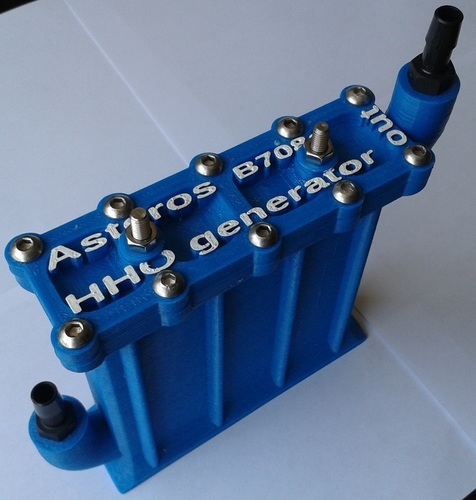
Asteros B708a 3d printed Hydrogen Generator
pinshape
Summary This model of Asteros Hydrogen 3D printed generator is built from three precision-crafted components designed in Tinkercad and printed on a highly calibrated Prusa I3 3D printer using Steel 316L plates cut with laser precision on an AutoCAD 2007-designed cutting tool. With this project, multiple groups of students can collaborate to achieve Architect and mechanical design advancements. Print this model to experience instant car fuel savings or get inspired to create and print your own HHO Generator! This I hope will demonstrate the vast potential of 3D printing. More innovative projects are on the horizon. Plates DXF file is available for download. Assembling documents and parts list + printing video tutorial provide comprehensive guidance. Print Settings: Printer: Prusa I3 Rafts: No Supports: No Resolution: 0.2 Infill: 100% Note: It is recommended to use a Brim of at least 4.8 mm when printing ABS. Scale it to fit your building volume or print separate the upper barb out and glue it with acetone. Carefully check the proper connecting of the separator, as improper connection can lead to overheating and damage to the generator, potentially resulting in an explosion risk. How I Designed This I designed this hydrogen generator to reduce my fuel bills. The simple reason I chose a 3D printer is that only it can produce the separator and other parts within hours, even if some parts can only be 3D printed. Anyone with a 3D Printer can print one for themselves. I previously worked on an early version of this HHO generator using a CNC machine but achieved better results with expensive jewelry CNC machines, which made me consider alternative cost-effective options. I opted for the best choice with a bright future: 3D printing. Project: Asteros B708a 3d printed Hydrogen Generator Objectives: This project aims to educate students on how far-reaching science is and how this hydrogen generator uses every submitted ampere current to produce hydrogen, showcasing the capabilities of 3D printing. Students can also try designing further improvements to the generator, such as separating HH from O or changing the shape for better aesthetics. Audiences: Ages 18+ are suitable for this Project due to the hazardous nature of HHO and the need for special care when handling and manipulating it. Preparation: * Computer with internet access and 3D modeling software * 3D printer (students can use any model, but Prusa I3 is recommended) * SSteel plates can be ordered with DXF files provided on a laser cutter from relevant companies Step 1: Make changes to the model using Tinkercad or similar 3D editing software and update the DXF files for the Plates with AutoCAD. Step 2: Print all parts of the generator on a 3D printer in your chosen color. Step 3: Order SSteel plates and assemble the generator as shown, considering any design changes made during the process. Result: The most innovative student should achieve improvements to the HHO generator's appearance or functionality, potentially even bringing it to the next level by creating a separator.
With this file you will be able to print Asteros B708a 3d printed Hydrogen Generator with your 3D printer. Click on the button and save the file on your computer to work, edit or customize your design. You can also find more 3D designs for printers on Asteros B708a 3d printed Hydrogen Generator.
